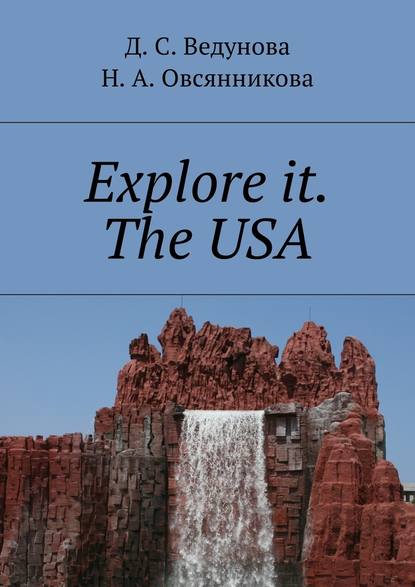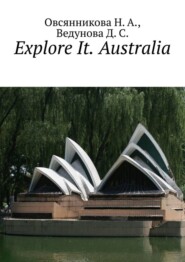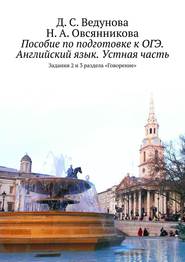По всем вопросам обращайтесь на: info@litportal.ru
(©) 2003-2024.
✖
Explore it. The USA
Настройки чтения
Размер шрифта
Высота строк
Поля
Because of the direction of the wind in the cold seasons on the southern and eastern shores of lakes, the snowy effect of the lake appears.
Rivers of the USA.
Snake is the largest tributary of the Columbia River. Its length is about 1735 kilometers, and the basin area is 278,450 square kilometers. The beginning of Snake takes in the west, in the district of Wyoming. Runs on the territory of 6 states in the region of mountain plains. Has a huge number of tributaries, the largest – Palus with a length of 270 km. Snake is a navigable river. Its main food is due to snow and rainwater.
Colombia is located in North America. Presumably its name was in honor of the ship of the same name, on which Captain Robert Gray traveled – he was one of the first who discovered and passed the whole river. Its length is 2000 kilometers, and the area of the basin is 668,217 square kilometers. km. It has more than 60 tributaries, the largest of which are: Snake, Willamette, Kuteni and others. It flows into the Pacific Ocean. Colombia feeds on glaciers, due to which it has a large volume of water and a fairly fast current. More than a dozen hydroelectric power stations have been built on its territory. Like Snake, Colombia is navigable.
Ohio – one of the largest rivers in the United States, is the most full-fledged tributary of the Mississippi. Its length is 2102 kilometers, and the pool area is 528,100 square kilometers. The pool is formed by the confluence of two rivers – Allegheny and Monongahil, originating in the Appalachian mountains. Its main tributaries are Maiami, Maskingham, Tennessee, Kentucky and others. On Ohio, there are strong floods, which are catastrophic. The food of the river is due to groundwater, rainwater, as well as from the rivers flowing into it. One of the largest hydroelectric power stations in the country is built in the Ohio basin.
Southern Red River (Red River) – one of the longest American rivers, is one of the largest tributaries of the Mississippi. Its name was due to clay lands in the watershed of the river. The length of the Red River is about 2190 kilometers. It was formed from the confluence of two small Texan rivers. The South Red River was blocked in the 1940s by a dam to prevent devastating floods. The Red River was surrounded by Tehomo lakes, formed as a result of the installation of the dam, and Fr. Caddo, next to which is located the largest cypress forest on earth. The food of the river is rain and soil.
Colorado is located in the south-west of the United States and is one of the largest and most beautiful rivers of not only the country but also the world. Its total length is 2334 kilometers, and the area of the basin is 637,137 square kilometers. km. Colorado starts from the Rocky Mountains, and connects to the Pacific Ocean in the Gulf of California. Colorado has more than 25 tributaries, the largest are Eagle River, Green River, Hila, Little Colorado and others. It is one of the most controlled rivers in the world: it has 30 large dams. The first of them was built in 1907 and formed the reservoir Powell. In the waters of Colorado, there are about 50 species of fish.
Arkansas is one of the longest rivers and the largest tributaries of the Mississippi. It begins in the Rocky Mountains, Colorado. Its length is 2348 kilometers, and the pool area is 505,000 square kilometers. km. It crosses four states: Arkansas, Kansas, Colorado, Oklahoma. The largest tributaries of Arkansas are Simarrok and Salt Fork-Arkansas. Arkansas is a navigable river and is a source of water for local residents. Because of the rapid current in the mountainous areas, the river has become popular among tourists who want to go in for extreme swimming.
Rio Grande (Great River) – the largest and longest river in North America. It is on the border of two states of the USA and Mexico. The Mexican name is Rio Bravo. The Rio Grande takes its start in the state of Colorado, the mountains of San Juan and flows into the Gulf of Mexico. The most important and large tributaries are the Rio Conchos, Pecos, Devils River. Despite its size, the Rio Grande is not navigable, as it has considerably become shallow. Due to shallowing under threat of extinction are some species of fish and animals. Rio Grande in some areas can dry up and form small ponds, such as lakes. The main food is rain and snow water, as well as mountain keys. The length of the Rio Grande is 3,057 kilometers, and the area of the basin is 607,965 square kilometers.
Yukon (Big River) opens the three longest rivers in the United States. The Yukon flows around the state of Alaska (USA) and in the northwest of Canada. It is a tributary of the Bering Sea. Its length is 3184 kilometers, and the pool area is 832,000 square meters. It begins in Lake Marsh and then moves to the border with Alaska, dividing the state into two equal parts. Its main tributaries are Tanana, Pelly, Koyukuk. Yukon is navigable for three months, as the rest of the year it is covered with ice. The big river is in a mountainous area, so it is full of rapids. In its waters there are valuable species of fish such as salmon, pike, nelma, grayling. The main food of the Yukon is snow water.
Missouri (Big and muddy river) is the longest river in North America, and also the largest tributary of the Mississippi. Its origin Missouri takes in the Rocky Mountains. It flows on the territory of 10 US states and captures 2 Canadian provinces. The river stretched for 3,767 kilometers and formed a basin with an area of 1,371,010 square meters. km., which is one-sixth of the entire territory of the United States. It was formed by the confluence of the rivers Jefferson, Gallatin and Madison. Missouri takes about a hundred major tributaries, the main are Yellowstone, Platt, Kansas and Osage. The turbidity of the Missouri water is explained by the washing out of the mountain stream by a powerful stream of the river. The river feeds on rain and snow waters, as well as the waters of tributaries. Currently it is navigable.
Mississippi is the most important river in the United States, and also ranks third in the world (in the confluence with the tributaries of Missouri and Jefferson) along the lengths after the Amazon and the Nile. It was formed from the confluence of the rivers Jefferson, Madison and Gallatin. Its source is the lake of Aitask. It occupies a part of 10 US states. Uniting with its main tributary of Missouri, it forms an extension of more than 6,000 kilometers. The river’s own length is 3,734 kilometers, and the area of the basin is 2,981,000 square kilometers. The food of the Mississippi is mixed.
The climate
Due to the large size of the country, its length and wide variety of geographical features in the US, it is possible to find areas with almost any climatic characteristics. Most of the USA (states south of 40 degrees north) is located in the subtropical climate zone, temperate climate prevails to the north, Hawaii and southern Florida lie in the tropics, and the north of Alaska belongs to the polar regions. The great plains to the west of the 100th meridian are classified as semi-deserts, the Great Basin and the areas around it are arid, and the coastal regions of California are a Mediterranean climate. The type of climate within the boundaries of one belt can vary significantly depending on the terrain, the proximity of the ocean and other factors. The favorable climate had a considerable influence on the settlement of the continent by Europeans and in many ways contributed to the US occupying the leading positions in the world.
The overall temperature background is fairly uniform. In summer, the temperature in most areas ranges from +22° C to +28° C, with the difference between the northern and southern states is relatively small. Winter in most of the country is quite mild – the average January temperature ranges from -2° C in the north to +8° C in the south. However, considerable temperature fluctuations are not uncommon due to free penetration of air masses both from the Arctic region and from tropical latitudes (the mountain systems of the USA located in the meridional direction act as a kind of «pipe» through which cyclones and anticyclones move from north to south or vice versa, practically without encountering obstacles). In the mountainous regions it is always cooler than in the adjoining territories of the plains – in the summer by 4—8 degrees, in winter – by 7—12. At the same time, in the pre-oceanic regions in winter it is always warmer, and in the summer it is cooler than in the center of the country (the eastern coast of the country, heated by the warm Gulf Stream, has a temperature 5—7 degrees above all central and western regions).
Depending on the nature of the mountain systems, weather stability also changes markedly: in low Appalachians the climate differs little from the flat areas of the east of the country and is quite constant, while the extensive and high ridges of the Cordillera system are widely known for their cooler, dry and unstable weather.
The nature of the distribution of precipitation is also very uneven. In the southeastern states and on the Pacific coast, it drops to 2000 mm of rain per year, in the Hawaiian Islands – up to 4000 mm and more, while in the central regions of California or Nevada – no more than 200 mm. And the nature of the distribution of precipitation depends entirely on the terrain – the western slopes of the mountains and the Atlantic regions receive significantly more rain than the eastern ones, while in the entire Great Plains, from the coastal lowlands of the south to the wooded areas of the north, there is almost the same amount of precipitation 300—500 mm).
At any time of the year, you can find the US region, where rest would be comfortable in its weather conditions. The swimming season in the north and in the center of the Atlantic coast lasts from June to August-September, although to quite acceptable values the water warms up in May and in October. On the coast of Florida you can swim practically all year round (the average temperature of the water even rarely falls below +22° С even in winter months), however in the period from July to September it is quite hot (+36—39° С) and very high air humidity (up to 100%), and from June to November, tropical hurricanes are not uncommon.
The Pacific coast has a noticeably larger difference in water and air temperatures between the northern and southern regions. In the southern part of the coast, you can swim practically all year round, although in the period from November to March even in California, the temperature of the water rarely rises above +14° C (many seas with well-heated water are used for sea recreation). At the same time in the north, in Oregon and Washington, even in the summer months, there are often noticeable cold snaps of both water and air, in winter the temperature regime is quite common for regions with a temperate marine climate (air from -6 to +4° C, water – about +4° C). Contrary to popular belief, Oregon’s climate is dry enough (rain falls less than in Atlanta or Houston) and warm enough (summer highs rarely exceed +30° C, and in winter the thermometer remains at +2° C). Therefore, you can find excellent opportunities for recreation almost all the year round.
To the north, in the state of Washington, two distinct climatic zones, west of the Cascade Mountains, on the Pacific coast and in Seattle, quite clearly distinguish themselves, in the summer, it is rarely hotter than +26° C, and in the winter – colder +8° C, while the eastern part of the staff has a noticeably warmer summer and a cool winter. Traditionally, the summer tourist season here begins with Memorial Day and continues until Labor Day, and even some of the sights are open to visitors only during this period.
The central mountain areas can be visited all year round, in the southern part of the Rocky Mountains in the summer it is too hot (+26—34° C), therefore it is recommended to plan your trip for the spring or autumn. To avoid the influx of tourists, it is recommended to plan visits to national parks, for example, in late autumn or early spring, when the weather conditions are quite comfortable. The western slopes of the Rocky Mountains and the eastern part of California during the summer are also not very pleasant to visit – too hot, however, the seaside part of the same California at this time has quite pleasant weather conditions.
There are no seasonal restrictions for visiting Los Angeles. Despite its dry and hot semi-desert climate, the city is protected from the burning heat by mountain chains in the north and east, as well as by the Pacific Ocean itself. August and September are the hottest months (+24—30° C), January and February are the coolest (around +12° C) and the wettest, but at any time of the year ocean breezes soften the weather in the direction of greater comfort. However, the city smog combined with the summer heat makes the end of the summer not the best time to visit the metropolis, while the resort areas adjacent to it from the north and south have excellent weather conditions during this period.
The climate of Alaska is quite severe, since 30% of its territory is beyond the Arctic Circle. In northern and central regions with their subarctic climate, the thermometer’s column often drops to -45-50° C in winter, while in summer the air warms up to +16—20° C (in northern regions – +2—6° C) with very low precipitation (about 250 mm per year). In the southern and central regions the climate is temperate marine, the average temperature here in the summer is about +18° C, but often the air warms up to +30° C), in winter – from -6° C to +4° C, precipitation falls from 400 to 600 mm per year.
The vegetation of the USA
Through the territory of the United States there are various climatic zones, and in some parts of this vast country there is a truly unique microclimate in which an amazing plant world has formed.
Of course, the economic development of the North American continent played a role, however, rather large areas, about 30%, are now covered by forests. In general, coniferous species predominate – spruce, pine, fir. In the north-east of the country there are massifs of mixed forests, where, in addition to coniferous trees, grow oaks, maples, plane trees, birches, ash trees, sycamore. In the Mojave Desert, there are also original forests – cactus. In Alaska, the most northerly state of the USA, only mosses and lichens grow, in deserts and semi-deserts – shrubs, yucca, wormwood, quinoa, in alpine and subalpine meadows – heather and other flowering plants. Closer to the south, there are magnolias and rubber trees, on the coast of the Gulf of Mexico – mangrove forests, on the west coast – citrus trees, and in Hawaii – tropical jungles with palm trees, lianas, orchids and other exotic representatives of the flora. Vegetation of national parks and reserves is also unique. In the Yellowstone National Park, which has existed for more than 130 years, there are 1,870 plant species, of which the predominant majority are native species.
Most of the forests of the park are filled with pine conifer. In the undergrowth there are deciduous trees: birch, willow, aspen. In the Everglades National Park, more than 2,000 plant species are represented (different species of mangrove, mahogany, oak, willow, cypress, pine etc.). Also here are preserved in their original form tropical marshes with 25 species of orchids.
In the Zion National Park, there are mixed and coniferous forests, desert and coastal vegetation – only 450 species. In the Yosemite National Park, there are 1600 plant species, of which 160 are endemic. Next to it is broken the Sequoia park, where the tallest trees in the world grow. The highest sequoia called «Hyperion height» has a height of 115.5 meters. The northernmost part of the rain forest in the world is located in the Olympic Park. It is also the wettest area on the mainland of the United States.
Fauna of the USA
The rich fauna of the United States is mainly due to the vast expanses and careful protection of nature, which already had to suffer a lot of troubles from man.
The animal world of the US, although it has some similarities with the European one, however, there are unique animals on the North American continent. To the common animals with Eurasia one can include deer, moose, wolf, hare, sable, ermine, wolverine, woodpeckers, owls, etc. Unique North American animals are porcupines, martens ilka, large flying squirrels, red squirrels, etc.
The nature of the animal world is mainly determined by climatic conditions and vegetation. In broadleaf forests, black bears (baribals) and grizzly bears, virgin deer, red lynx, cougar, possums, skunks, chipmunks are common. In mixed forests live brown bears, lynxes, martens and wolverines. Alaskans arrange seals and walrus rookeries. In the steppes, in addition to large artiodactyls (bison, deer, vilorogie antelope, thick-legged sheep), there are foxes, coyotes, badgers, ferrets. Bison was mercilessly exterminated by man for the sake of valuable skins, but at present they are under the protection of the law. Deserts are inhabited mainly by small mammals (marsupials, etc.), reptiles (snakes, lizards, iguanas), as well as insects (scorpions, spiders, etc.). In the tropical forests of the Gulf Coast there are crocodiles and alligators, as well as anteaters, porcupines and marmosets. In the reservoirs live nutria, muskrats, beavers, as well as amphibians – frogs, toads, newts.
Birds living in the United States are very diverse. In the middle latitudes you can observe owls, vultures, eagles, mockingbirds, cranes, snipe, peregrine falcon, cormorants. In the south of the country there are more exotic species – parrots, flamingos, pelicans, hummingbirds.
The fish world is mainly represented by salmonids – only in the Yellowstone reserve are 18 species. Near the Hawaiian Islands, 600 species of tropical fish adjoin the turtles.
Save a huge species diversity of the animal kingdom of the United States help the extensive national parks and reserves. The largest species diversity of mammals, birds, fish and insects can be found in the national parks of Yellowstone, Everglades, Zion (about 300 bird species), Bryce Canyon (60 mammal species and 160 bird species), Santa Ana (the largest bird sanctuary). In the world-famous Yellowstone Reserve, the largest populations of bison, grizzly bears, pumas and wolverines have been preserved. In the Everglades National Park, where tropical marshes are preserved, there are co-existing Mississippian alligators and sharply crocodiles, as well as numerous bird species, including exotic ones.
Natural wonders of the USA
1. GRAND CANYON
One of the most unusual, deep and beautiful canyons of the world more than deserves a visit. It is located on the territory of the National Park of the same name in Arizona and attracts about 4 million tourists every year. We recommend climbing the observation deck «Grand Canyon Skywalk», which provides an excellent overview of this natural wonder – not least thanks to the glass floor. The main thing – not to dizzy, because the depth of the canyon in some places reaches 1800 meters.
2. NIAGARA WATERFALL
One of the most beautiful and majestic waterfalls in the world is a must on the list of «must see» American natural attractions. There is nothing to talk about here, because this is a beautiful sight to see with your own eyes.
3. THE DEATH OF DEATH
The place is not for the faint-hearted, and it’s not just a rather ominous name. This is an incredibly hot place, where the highest temperature in the world was recorded at one time, so it’s better to plan a visit to the Valley from November to February, when it’s cooler here. It is here that the famous Moving Stones are located, in addition, thanks to a truly alien landscape, here were shot episodes of many films, including the fourth part of the «Star Wars».
4. THE MAMMONT CAVE
In fact, this is a whole cave system, which is considered to be the longest in the world, so if the speleologist is drowsy in you – here. To the mammoths, this cave, which appeared as much as 10 million years ago, has no relation – this name appeared due to the play of words in the English language, according to which one of the meanings of the word «mammoth» is huge. Earlier on the underground river Echo, which is located on one of the lower levels, excursions were conducted on boats, but now this practice is a thing of the past. Although this underground kingdom may seem somewhat eerie, it definitely has a unique beauty.
5. FLY GEYSER
Fly is a geyser that has become one of the most famous in the world, despite the rather small height, which jets of water rises (it is only 1.5 meters). The geyser is surrounded by very beautiful stone formations, the color of which, due to mineral layers and algae, is very unusual, and represents a single natural ensemble.
6. LAKE CASCO
Lake Caddo Texas
Considering the photos of this unusual lake, you might think that it is straight from a mystical film – it has such an unusual atmosphere. The labyrinth of the channel, surrounded by rare Arizona cypresses, attracts travelers: when going for a walk along this water system, it is worthwhile to be cautious, because sometimes people are lost here (however, they are found alive and unharmed). At first sight, because of the countless number of water lilies and covered with duckweed lawns, Caddo resembles a swamp, but the water here is clean and fresh, and the natural complex is very beautiful.
7. THE SCREEN LAKE










